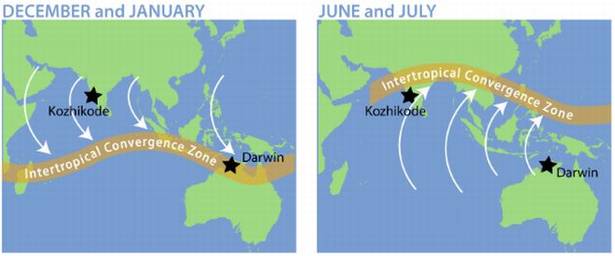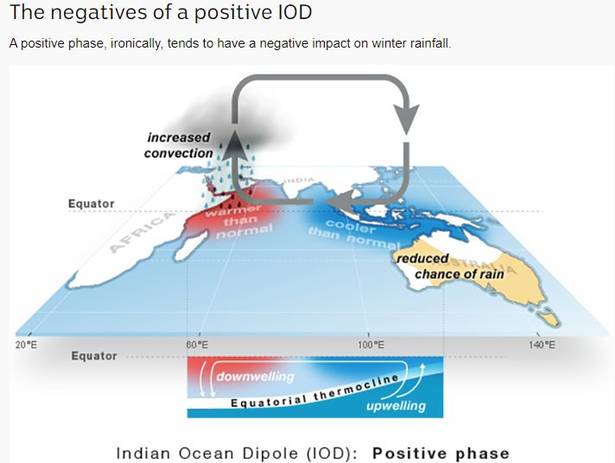Geography
Indian Ocean Dipole and the South-West Monsoon
- 21 Oct 2019
- 4 min read
According to the Australian Bureau of Meteorology, the delayed withdrawal of South-west monsoon in India has had a cascading impact on the summer monsoon for Australia.
- This exemplifies how a particular climatic phenomenon, geographically affects national and international aspirations.
Background
- The fundamental driver of monsoon systems on Earth is the solar heating of the land.
- During the summer season (in India), this heating of land helps to establish a land-sea temperature difference.
- Land heats up faster than water that causes the air to expand thus lowering the atmospheric pressure of the land. This pressure difference begins the wind movement from the seas towards the land (wind flows from a high-pressure area to a lower-pressure area).
- The moisture then falls on the Earth as rain through the process of convection as the monsoonal rains over the regions mainly India and South-East Asia.
- When there is a change in season (i.e, winters in Northern Hemisphere), the sun moves towards the Tropic of Capricorn where the sun's rays begin to overhead the Southern Hemisphere heating the adjacent ocean more than the Asian land.
- As a consequence of this change in the sun’s position, the winds reverse, and the monsoonal rainfall moves to the opposite hemisphere during the Austral summer (i.e, summer in the Southern Hemisphere, time period: December-February).
- The phenomenon of normal monsoonal wind flow is affected by the presence of positive phase of Indian Ocean Dipole (IOD), which this year drove the Indian monsoon to a peak.
- Because of the positive phase of IOD, the 2019 monsoon in India started its withdrawal on October 9, against the normal date of September 1, and is the most delayed in recorded history.
Indian Ocean Dipole (IOD)
- The positive IOD refers to the warmer western basin of the Indian Ocean as compared to the Eastern basin.
- This year (2019), over the past month, strong easterly trade winds across the tropical Indian Ocean have aided the upwelling of cooler water in the eastern Indian Ocean (closer to Australia).
- At the same time, warm waters off the Horn of Africa (West Indian Ocean) have caused an even greater temperature across the basin.
- Impact of IOD on Australia
- The impact of a delayed monsoon may have implications for Australian summer crops with the decline in planted area (approx. fall of 28%) in 2019–20.
- Typically, a positive IOD brings below-average winter-spring rainfall to southern and central Australia and a more severe fire season for South-East Australia.
- In the tropical Pacific Ocean, the El-Nino Southern Oscillation (ENSO) remains neutral.
- When ENSO is neutral, it has little effect on Australian and global climate, meaning other influences are more likely to dominate.








